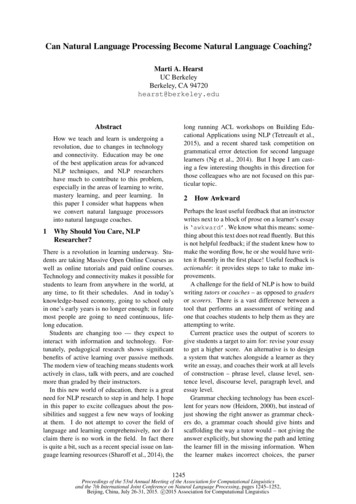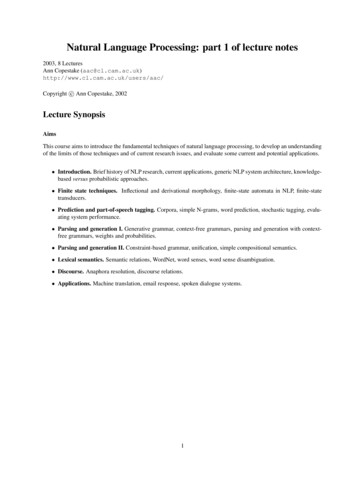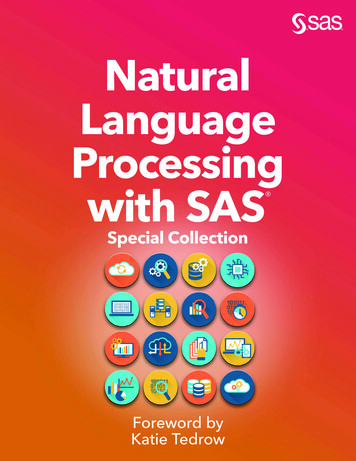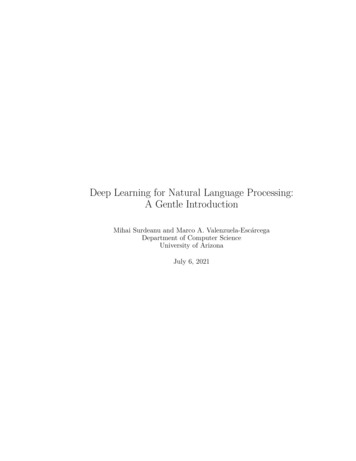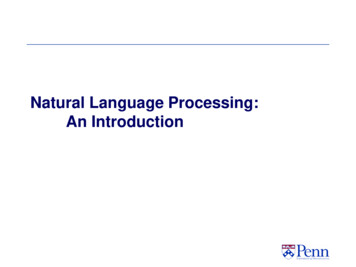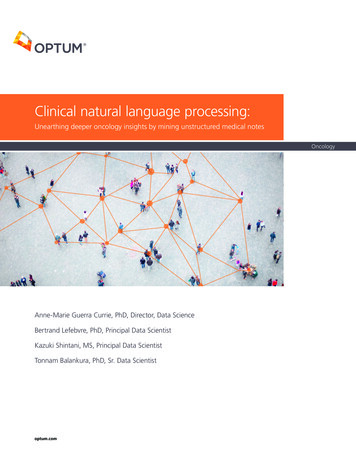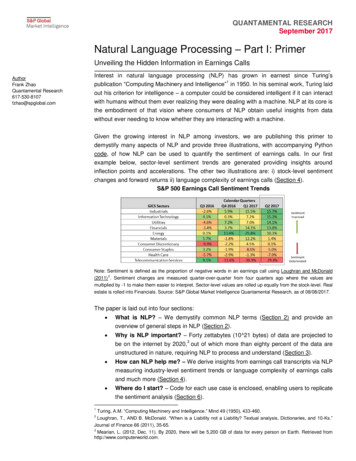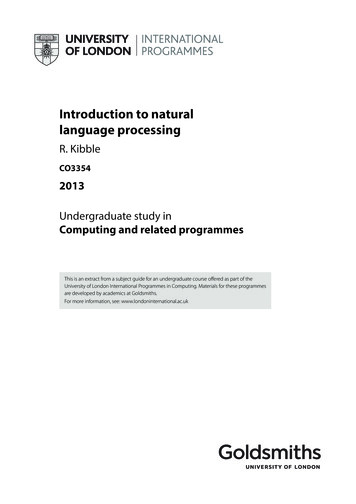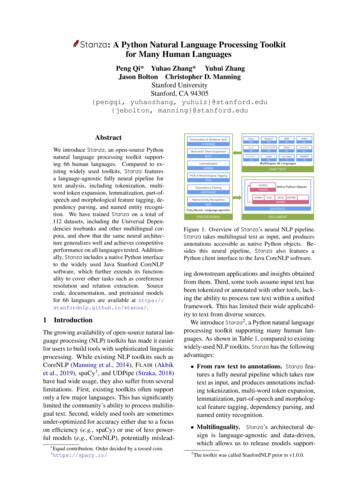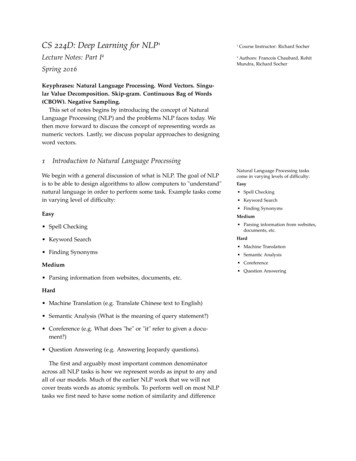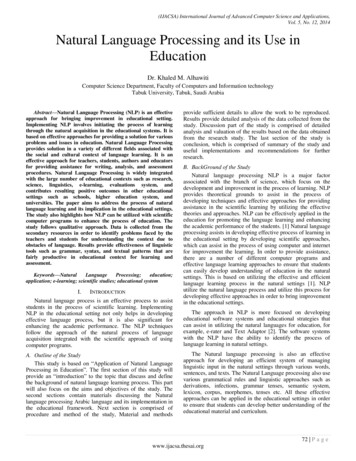
Transcription
(IJACSA) International Journal of Advanced Computer Science and Applications,Vol. 5, No. 12, 2014Natural Language Processing and its Use inEducationDr. Khaled M. AlhawitiComputer Science Department, Faculty of Computers and Information technologyTabuk University, Tabuk, Saudi ArabiaAbstract—Natural Language Processing (NLP) is an effectiveapproach for bringing improvement in educational setting.Implementing NLP involves initiating the process of learningthrough the natural acquisition in the educational systems. It isbased on effective approaches for providing a solution for variousproblems and issues in education. Natural Language Processingprovides solution in a variety of different fields associated withthe social and cultural context of language learning. It is aneffective approach for teachers, students, authors and educatorsfor providing assistance for writing, analysis, and assessmentprocedures. Natural Language Processing is widely integratedwith the large number of educational contexts such as research,science, linguistics, e-learning, evaluations system, andcontributes resulting positive outcomes in other educationalsettings such as schools, higher education system, anduniversities. The paper aims to address the process of naturallanguage learning and its implication in the educational settings.The study also highlights how NLP can be utilized with scientificcomputer programs to enhance the process of education. Thestudy follows qualitative approach. Data is collected from thesecondary resources in order to identify problems faced by theteachers and students for understanding the context due toobstacles of language. Results provide effectiveness of linguistictools such as grammar, syntax, and textual patterns that arefairly productive in educational context for learning ;education;application; e-learning; scientific studies; educational systemI.INTRODUCTIONNatural language process is an effective process to assiststudents in the process of scientific learning. ImplementingNLP in the educational setting not only helps in developingeffective language process, but it is also significant forenhancing the academic performance. The NLP techniquesfollow the approach of the natural process of languageacquisition integrated with the scientific approach of usingcomputer programs.A. Outline of the StudyThis study is based on “Application of Natural LanguageProcessing in Education”. The first section of this study willprovide an “introduction” to the topic that discuss and definethe background of natural language learning process. This partwill also focus on the aims and objectives of the study. Thesecond sections contain materials discussing the Naturallanguage processing Arabic language and its implementation inthe educational framework. Next section is comprised ofprocedure and method of the study, Material and methodsprovide sufficient details to allow the work to be reproduced.Results provide detailed analysis of the data collected from thestudy. Discussion part of the study is comprised of detailedanalysis and valuation of the results based on the data obtainedfrom the research study. The last section of the study isconclusion, which is comprised of summary of the study anduseful implementations and recommendations for furtherresearch.B. BackGround of the StudyNatural language processing NLP is a major factorassociated with the branch of science, which focus on thedevelopment and improvement in the process of learning. NLPprovides theoretical grounds to assist in the process ofdeveloping techniques and effective approaches for providingassistance in the scientific learning by utilizing the effectivetheories and approaches. NLP can be effectively applied in theeducation for promoting the language learning and enhancingthe academic performance of the students. [1] Natural languageprocessing assists in developing effective process of learning inthe educational setting by developing scientific approaches,which can assist in the process of using computer and internetfor improvement the learning. In order to provide assistance,there are a number of different computer programs andeffective language learning approaches to ensure that studentscan easily develop understanding of education in the naturalsettings. This is based on utilizing the effective and efficientlanguage learning process in the natural settings [1]. NLPutilize the natural language process and utilize this process fordeveloping effective approaches in order to bring improvementin the educational settings.The approach in NLP is more focused on developingeducational software systems and educational strategies thatcan assist in utilizing the natural languages for education, forexample, e-rater and Text Adaptor [2]. The software systemswith the NLP have the ability to identify the process oflanguage learning in natural settings.The Natural language processing is also an effectiveapproach for developing an efficient system of managinglinguistic input in the natural settings through various words,sentences, and texts. The Natural Language processing also usevarious grammatical rules and linguistic approaches such asderivations, infections, grammar tenses, semantic system,lexicon, corpus, morphemes, tenses etc. All these effectiveapproaches can be applied in the educational settings in orderto ensure that students can develop better understanding of theeducational material and curriculum.72 P a g ewww.ijacsa.thesai.org
(IJACSA) International Journal of Advanced Computer Science and Applications,Vol. 5, No. 12, 2014Natural Language Processing is a widely recognized area inthe language learning all over the world. It is successfullyimplemented in different languages as an effective way forbringing improvement in the educational systems. English isthe most commonly recognized language in most of theresearched studies, which reveals it’s effective of utilizingnatural language learning process in educational process. NLPis also effective approach for bringing improvement in theeducational system in Arab countries [3]. Despite that there arevarious approaches for bringing improvement in the social andeducational settings; NLP is the best suitable approach, inwhich natural language processing use to create NLP tools topromote the education. These tools are based on utilizingvarious effective approaches for assisting in the process ofeducation at college and university level. This requiresdeveloping the tools and corpus resources for the educationalsystem in Arabic language.C. Aims and ObjectivesThe major aims and objectives of this study is to Understand the natural language learning processing. The objective of this study is to apply the naturallanguage processing NLP in educational setting.II.MATERIAL AND METHODSThis study is based on qualitative approach. Method of datacollection is based on gathering information from thesecondary resources and analysis of the theories, which supportand assist in understanding the natural language process and itsimplementation in the education. Various problems faced bythe teachers and students for understanding the context due toobstacles of language. The use of effective linguistic tools suchas grammar, syntax, and textual patterns are very effective forlearning and assessment of text. The study is based on aqualitative approach. Method of data collection is based ongathering information from the secondary resources andanalysis of the theories, which support and assist inunderstanding the natural language process and itsimplementation in the education. Various problems faced bythe teachers and students for understanding the context due toobstacles of language. The use of effective linguistic tools suchas grammar, syntax, and textual patterns are very effective forlearning and assessment of text. [4]A. NLP and Educational SettingThere are a number of different effective approaches in theNLP, which assist in educational settings such as role ofempirical data, corpora, and other such linguistic aspects,which are essential and effective for the process of languagelearning. Corpora are very effective, which provides a largenumber of computational data for spoken and written language.For example, in British English, BNC (the British NationalCorpus) provides a large data about the vocabulary usage [4,5].The large collection of information provides sufficient dataregarding the usage of words, which assist enhancing theinformation and academic skills of the students.There are various effective approaches, which are effectivefor managing patterns of grammar and other linguisticapproaches. NLP is also an effective technique for assessmentprocess to enhance the ability of students to identify therelationships of different words and the use of such words inthe search engine for generating treasure [5].Therefore; it is aneffective approach, which allows learners and teachers to usethese words more efficiently. The assessment procedurerequires entering correct information in the text in order toenter in the next level. NLP assessment allows analysis of thestudents’ information by matching it with the requirement ofthe content [6].B. Tools and MethodsHaving access to a variety of tools, NLP enjoys theimplementation in multiple fields such as laboratory, faculty ofinformation, e-learning, and in the field of education.Availability of search engines also provide sufficientinformation for information search, but language constraintsare a major issue for majority of students, which hinders theprocess of language learning through electronic sources andonline material available on internet. The natural languagelearning processing is also associated with the understanding ofvarious effective linguistic tools such as grammaticalconstruction, syntax, sentence composition, etc [7].The application of NLP in the area of e-learning is aneffective approach, especially its application in the area ofeducations. The natural language processing can assist studentsin developing general understanding of the cognitive andpsychological perspectives that play an important role in thelanguage acquisition. In the educational process, naturallanguage processing can be implemented effectively to ensurethat there are various positive attributes of this approach suchas specification of the synchronous or asynchronous mode. [8]The methods for the implementation of NLP in educationrequires using the approach of e-learning or the utilization ofteaching material for bringing improvement for furtherdevelopment [8,9].The method or the process of this study alsorequires implementation of the effective approaches andutilization of the language resources for bringing improvementin the system of education. There are also a large number oftools and methods, which assist in utilization of languagetechnology such as linguistics software systems, which are veryeffective for managing and dealing with the need to bringimprovement in the educational system [9].The implementation of language tools can assist indeveloping better understanding of the content such as betterunderstanding of material while reading, development of thereading text and material. There are two sides of theeducational system: learning and teaching. Thus, tools forteaching and learning are both effective for assisting theprocess of educations such as websites, publications, digitallibraries, e-books, podcasts, and scientific materials [10]. Thisis one of the most effective approaches, which allows studentsand teachers to focus and to explore more in the field of study.There are various effective methods to implement NLP in theeducational settings such as classification and categorization ofdifferent sources in the learning perspectives. This can assist inidentification of the authentic sources and avoiding the use ofunreliable resources.73 P a g ewww.ijacsa.thesai.org
(IJACSA) International Journal of Advanced Computer Science and Applications,Vol. 5, No. 12, 2014Another method to assist language learners is through theprocess of enabling students to concentrate on their coursematerial and content of the given topic. This approach is basedon matching the course content knowledge of learners; thismethod is derived from the assessment procedure of NLP. Forexample, students can be asked to write an essay, whichmatches their curse content with the current informationgathered from the online source. [11]C. TheoryReference [2] discussed emerging opportunities forbringing improvement in the natural language process NLP andits effectiveness for developing various educational tools suchas for reading and writing content. According to Reference entations for the technology based computer systems.Advancement of computer technology and the increase inapproach of second language learning has resulted in the trendof using language as a major tool for providing assistance inthe educational settings. According to Burstein, “the generallack of computer based technology proved to be an obstacleearly on” [2].NLP allows the assessment of readability and textquality by analyzing the text quality especially n terms of thetext analysis.The linguistics aspects in the educational context can assistin managing and dealing with the complexities of reading andwriting. This can be done with the approach of analyzingsyntactic and morphological factors. Motivation in languagelearning is an effective approach, which can also be applied toenhance the educational practices and academic performance ofstudents [12]. Teachers can motivate students to focus anddevelop understanding of their content; it also requires utilizingeffective strategies for the students to set the programs invarious domains. The linguistic tools assist in the process ofevaluating and managing the problems of lexical and syntacticcomposition in writing and develop the understanding ofcontent [13, 14]. Learning and developing better understandingof language can also assist in better understanding of thecontent. The theory of natural acquisition of language is also aneffective approach to explain the ground for developing contentknowledge acquisition.III.RESULTS AND DISCUSSIONSA. Innovatiove Education Applications of NLPText Evaluator also known as Source Rater is a trendingtool that represent a trending concept for modeling textcomplexity, created to help assist developers assess sourcematerial for use in creation of new reading comprehensionpassages and items. This tool unites a large, cognitively basedfeatures set with sophisticated psychometric approaches inorder to present text complexity categorizations that are highlyassociated with categorization provided by experiencededucators.Language Muse is another example educational applicationof NLP, using a web-based application for instructionalauthoring and projected to support K12 instructors in thecreation of English-language learners’ curriculum material. Thelinguistic feedback given by this application highlightssentence structures, vocabulary, and discourse relations thatmay be identified in classroom texts that may be unfamiliar toELLs. Automated Generation of test items is anotherapplication towards the use of Natural Language Processing.[14]B. Natural Language Processing and EdcationNatural Language processing has various applications foreducational purpose. It is very significant to develop newsoftware systems and advanced techniques in the educationalsettings. The major purpose of using NLP in educational settingis to bring improvement in the educational system byimplementing efficient and effective policies, which can assistin utilizing advance technologies for the bringing improvementin the educational system. For example, application of NLP ineducation for e-learning is very significant approach, whichassist in producing educational material with technologicaldevelopment. Another significance of NLP application is theparticipation of both teachers and students. There are a numberof various electronic, online sources available in Englishlanguage, which assists students and teachers to accessmaterials. Apart from the convenience of availability of largenumber of online resources, another major concern isassociated with the increase in use of blogs, Wikipedia, andunreliable resources. This requires intelligent automaticprocessing for preventing the use of such unreliable resourcesand promoting the use of authentic resources. Application ofNLP in education is also effective for mining, informationretrieval, and quality assessment.C. Relationship between Language and TextResults based on the secondary sources and theoreticalgrounds reveal that text and technology have closerelationships. Students cannot understand content withoutproper understanding of the language. Without understandingof language, it is not possible for the learners to understand andretain information. The process of natural language acquisitionis one of the most important strategies that can assist in theprocess of language acquisition. The natural languageacquisition process along with the motivation from teachers canserve as a major source for bringing improvement in theacademic process of the students. Teachers and learners canboth focus on the strategies, which are efficient for utilizinglanguage in educational setting. For example, research studiesreveal that context analysis is not possible without developingthe understanding of text.According to Reference [15] the implementation of naturallanguage processing for education reveals that teachers andeducators can follow NLP approach for designing and planningcurriculum. This can also assists students to follow samestrategic approach for learning and understanding the content.The authors of texts and content can use this approach forstoring and coding the information for the students, andstudents follow same approach and linguistic composition fordecoding the text. Therefore, knowledge of natural languageprocess is effective for educators, teachers, authors, andstudents for better learning and understanding of the content,and improvement of writing skills. The results also suggest thatthis approach is effective for its application in the assistingstudents to study material from web resources, especially in thee-learning.74 P a g ewww.ijacsa.thesai.org
(IJACSA) International Journal of Advanced Computer Science and Applications,Vol. 5, No. 12, 2014D. Application of Natural Language Processing in EducationThere are a number of different effective approaches, whichassist in the process of e-learning and using web based currentinformation related to the educational course and curriculum.E-learning applications and tools provide assistance for thelearners to improve their education. Teachers also assist theirstudents for enhancing their skills and knowledge for gettingcurrent information using the online resources, which assists ingetting information from the online sources. NLP is also veryeffective for providing knowledge and information to thestudents for application of e-learning and NLP in understandingand dealing with the need of analyzing text. Understanding oftext is based on the development of research-based analysis ofthe general and contextual learning.The use of grammar, syntax, and sentence composition canbe efficiently utilized through linguistics software systems suchas grammar checkers, which are saves times and providesassistance for both teachers and learners. Therefore, there isneed for developing effective approach for the social andcultural perspectives. Implementation of NLP is also effectivefor using the e-learning approach in order to understand andlearn from the data available from the electronic sources. Thereare also future implementations of this research, which canassists in identifying the complex pattern in language. Furtherresearch can be conducted to identify its impact in individuallearning, understanding of context, and effectiveness of NLP inwriting and assessment procedure.Based on the research outcome, it is clear that students’output can be increased by implementing the NLP in theeducation. NLP is very effective approach for developing theunderstanding of students in the natural settings and assessingthe information available from the various sources. The betterunderstanding of information and ability to access theinformation from large amount of data available on websitesand other online sources can assist in generating and gatheringinformation. Therefore, based on the results and effectivenessof NLP in the educational context, it is clear that NLP can beeffectively applied for academic writing, assessment purposes,writing tests questions, and utilizing automatic writing systemsfor preparation of objective tests etc. [15][1]The application of NLP in education system is also veryeffective for analysis of errors in objective assessments and forthe assessment of essays. Various linguistic approaches andtools can be utilized for analyzing the errors such asgrammatical and stylistic errors. Teachers can easily markthese errors in the papers of students. There are variouseffective grammar checkers and evaluation sources, whichassist in resolving the problems of dealing with the currentprocess of learning. Teachers can use NLP for assessment ofmultiple-choice questions and analysis of grammatical patternin the text that needed to be analyzed. The application ofStandard e-learning method is very effective in order to ensurethat student can efficiently apply the data in the e-learningsystem. This approach is not only affective for its application inassessment, but it is also effective for writing purposes such aswriting material for digital libraries, websites, and various othersources.IV.CONCLUSIONSIn conclusion, Natural Language Processing and itsEducational Application provide a perfect solution to thevarious problems and barriers in the educational system, whichresult in affecting the academic progress and learning of thestudents. Language is one of the major concerns for thestudents. NLP with an effective approach for assisting theprogress and improvement in the learning ability of studentsbased on development and implementation of various effectivetools, assist writing, learning, and assessment of texts, such asuse of search engines, electronic resources and analysis ofgrammatical construction, syntax, sentence composition, etc.All these are the effective techniques, which can be utilized todevelop the structural framework for analysis of texts.REFERENCESNadkarni, P. M., Ohno-Machado, L., & Chapman, W. W. (2011).Natural language processing: an introduction. Journal of the AmericanMedical Informatics Association, 18(5), 544-551[2] Burstein, J. (2009). Opportunities for natural language processingresearch in education. In Computational Linguistics and Intelligent 00382-0 2#page-1[3] Habash, N. Y. (2010). Introduction to Arabic natural languageprocessing.Synthesis Lectures on Human Language Technologies, 0.2200/s00277ed1v01y201008hlt010[4] Liu, K., Hogan, W. R., & Crowley, R. S. (2011). Natural languageprocessing methods and systems for biomedical ontology learning.Journal of biomedical informatics, 44(1), 163-179.[5] De Vries, M. H., Monaghan, P., Knecht, S., & Zwitserlood, P. (2008).Syntactic structure and artificial grammar learning: The learnability ofembedded hierarchical structures. Cognition, 107(2), 763-774.http://dl.acm.org/citation.cfm?id 1967546[6] Pascual-Nieto, I., Santos, O. C., Perez-Marin, D., & Boticario, J. G.(2011, July). Extending Computer Assisted Assessment Systems withNatural Language Processing, User Modeling, and RecommendationsBased on Human Computer Interaction and Data Mining. In IJCAIProceedings-International Joint Conference on Artificial Intelligence(Vol. 22, No. 3, p. 2519).[7] Wahl, H., Winiwarter, W., & Quirchmayr, G. (2010, November).Natural language processing technologies for developing a languagelearning environment. In Proceedings of the 12th InternationalConference on Information Integration and Web-based Applications &Services (pp. 381-388). ACM.[8] de-la-Fuente-Valentín, L., Carrasco, A., Konya, K., & Burgos, D.(2013). Emerging Technologies Landscape on Education. A review.International Jorunal of Interactive Multimedia and nirioja.es/descarga/articulo/4426252.pdf[9] Felix, U. (2005). E-learning pedagogy in the third millennium: the needfor combining social and cognitive constructivist approaches. /action/displayAbstract?fromPage online&aid 305554&fileId S0958344005000716[10] Benson, P. (2013). Teaching and researching: Autonomy in /books?id ZoarAgAAQBAJ&printsec frontcover[11] Castellani, S., Kaplan, A., Roulland, F., & Roux, C. (2010). U.S. PatentNo. 7,797,303. Washington, DC: U.S. Patent and Trademark Office.http://www.google.com/patents/US7797303[12] Shi, C., Verhagen, M., & Pustejovsky, J. (2014). A ConceptualFramework of Online Natural Language Processing b.org/anthology/W/W14/W14-52.pdf#page 6375 P a g ewww.ijacsa.thesai.org
(IJACSA) International Journal of Advanced Computer Science and Applications,Vol. 5, No. 12, 2014[13] Najeeb, M. M., Abdelkader, A. A., & Al-Zghoul, M. B. (2014). ArabicNatural Language Processing Laboratory serving Islamic wnloads/Volume5No3/Paper 16Arabic Natural Language Processing Laboratory serving Islamic Sciences.pdf[14] Richards JC, Rodgers T (2001) Approaches and Methods in LanguageTeaching. Second Edition. New York: Cambridge University Press[15] Van den Branden (2012) Task-based language education. In: Burns A,Richards JC, The Cambridge Guide to Pedagogy and Practice inLanguage Teaching. New York: Cambridge University Press, 140–48.76 P a g ewww.ijacsa.thesai.org
Natural Language Processing and its Use in Education Dr. Khaled M. Alhawiti Computer Science Department, Faculty of Computers and Information technology Tabuk University, Tabuk, Saudi Arabia Abstract—Natural Language Processing (NLP) is an effective
